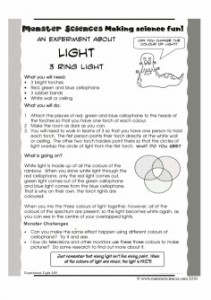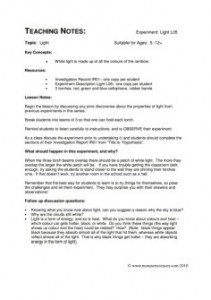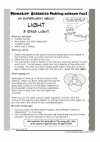Can you turn coloured light white again?
 |
 |
Monster Sciences Light Experiment: 3 Ring Light – Spectrum
What you will need:
- 3 bright torches
- Red, green and blue cellophane
- 3 rubber bands
- White wall or ceiling
What you will do:
- Attach the pieces of red, green and blue cellophane to the heads of the torches so that you have one torch of each colour.
- Make the room as dark as you can.
- You will need to work in teams of 3 so that you have one person to hold each torch. The first person points their torch directly at the white wall or ceiling. The other two torch holders point theirs so that the circles of light overlap the circle of light from the first torch. What do you see?
What is going on?
White light is made up of all the colours of the rainbow. When you shine white light through the red cellophane, only the red light comes out, green light comes out of the green cellophane and blue light comes from the blue cellophane. That is why on their own, the torch lights are coloured. When you mix the three colours of light together, however, all of the colours of the spectrum are present, so the light becomes white again, as you can see in the centre of your overlapped lights.
Just remember that mixing light isn’t like paint. When all the colours of light are mixed, the light is WHITE.
Monster Challenges:
- Can you make the same effect happen using different colours of cellophane? Try it and see.
- How do televisions and other monitors use these three colours to make pictures? Do some research to find out more about it.
Teaching Notes: Monster Sciences Experiment: Light L05
Topic:
Light
Key Concepts:
White light is made up of all the colours of the rainbow.
Resources:
- Investigation Record IR01– one copy per student
- Experiment Description Light L05– one copy per student
- 3 torches, red, green and blue cellophane, rubber bands
Lesson Notes:
Begin the lesson by discussing any prior discoveries about the properties of light from previous experiments in this series.
Break students into teams of 3 so that one can hold each torch.
Remind students to listen carefully to instructions, and to OBSERVE their experiment.
As a class discuss the experiment prior to undertaking it, and students should complete the sections of their Investigation Report IR01 from ”Title to “Hypothesis”.
What should happen in this experiment, and why?
When the three torch beams overlap there should be a patch of white light. The more they overlap the larger the white patch will be. If you have trouble getting the classroom dark enough, try asking the students to stand closer to the wall they are shining their torches onto. If that doesn’t work, try another room in the school such as a hall.
Remember that the best way for students to learn is to try things for themselves, so pose the challenges and let them experiment. They may surprise you with their answers and observations!
Follow up discussion questions:
- Knowing what you know now about light, can you suggest a reason why the sky is blue?
- Why are the clouds still white?
- Light is a form of energy, and so is heat. What do you know about colours and heat – which colour car gets hotter, black, or white. Do you think these things (the way light shows us colour and the heat) could be related? How? (Note: black things appear black because they absorb almost all of the light that hit them, whereas white objects reflect almost all of the light. That is why black things get hotter – they are absorbing energy in the form of light).



